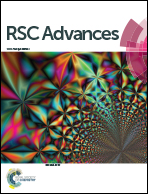Energy transfer cascade in bio-inspired chlorophyll-a/polyacrylamide hydrogel: towards a new class of biomimetic solar cells†
Abstract
We explored the energy transfer dynamics of chlorophyll-aentrapped polyacrylamide hydrogel with a vision of applying this hybrid material in a bio-inspired light harvesting system. Prominent photocurrent response was observed from a simple photovoltaic assembly prepared by encapsulating the hydrogel within two electrodes. For a better understanding of the energy transport, the hybrid systems were synthesized via two different methods (in situ and swelling induced). The difference in photocurrent efficiency among the two systems could be correlated with the different dynamic behaviors of the various excitonic packets and could be explained with environment-assisted transport of photosynthesis (ENAQT). This theory predicts that energy migration in a natural photosystem relies on the balance between coherence and dephasing, owing to the respective packing geometry. Fluorescence anisotropy supports the swollen induced arrangement of chlorophyll-a packets, which are inter-connected in terms of overlapping in site energy, as evident from the broadening of the UV-Vis spectra wherein coherent spreading occurs among around 4 chlorophyll-a molecules, as revealed from the time correlated single photon count. Exciton localization within the packets is destroyed by low frequency noise to mitigate coherence trapping in a coherent classical intermediate fashion, similar to ENAQT in natural photosynthesis, resulting in greater photocurrent efficiency. Optical and photo-physical properties of the in situ sample show that charged dimers are randomly spread throughout the system. As a result, delocalization is destroyed and energy propagation becomes less effective as the exciton is more likely to recombine than trap. The experimental signature of the environment-assisted energy transfer is further supported by a simple mathematical formulation inspired from Kassal's work. The concept of using swollen induced bio-inspired soft materials for solar energy harvesting can pave the way towards a new class of biomimetic solar cell.


 Please wait while we load your content...
Please wait while we load your content...